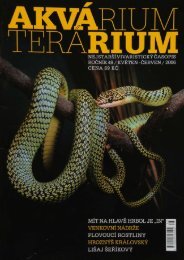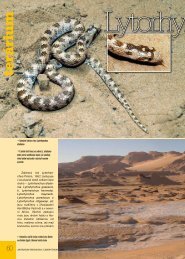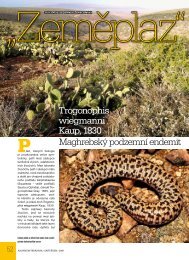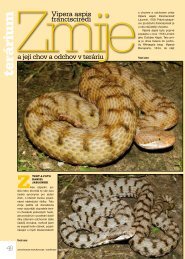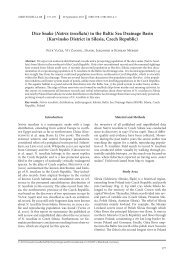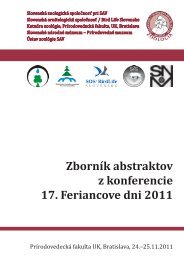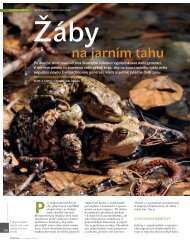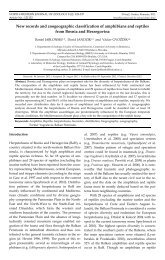Slow worm, Anguis fragilis (Reptilia: Anguidae ... - Daniel Jablonski
Slow worm, Anguis fragilis (Reptilia: Anguidae ... - Daniel Jablonski
Slow worm, Anguis fragilis (Reptilia: Anguidae ... - Daniel Jablonski
You also want an ePaper? Increase the reach of your titles
YUMPU automatically turns print PDFs into web optimized ePapers that Google loves.
V. Gvoždík et al. / Molecular Phylogenetics and Evolution 55 (2010) 460–472 461<br />
1992; Lác, 1967; Moravec, 1997; Rozínek et al., 2001), as well as<br />
the status of the Balkan populations, we focused our attention on<br />
genetic variation of A. <strong>fragilis</strong> using a broad-scale phylogeographic<br />
approach based on mitochondrial and nuclear DNA sequence data.<br />
2. Material and methods<br />
2.1. Sampling<br />
Tissue samples of individual <strong>Anguis</strong> specimens (n = 50; 43 localities)<br />
were obtained from museum voucher specimens (National<br />
Museum, Prague, Czech Rep., NMP; Natural History Museum of<br />
Crete, Irakleio, Greece, NHMC) and road-killed individuals. Oral<br />
swabs or miniature tail biopsy were occasionally taken from live<br />
animals. Three mitochondrial sequences and one nuclear (C-mos)<br />
sequence of four individuals originating from three different regions<br />
were taken from GenBank, together with two sequences of<br />
two outgroup species (Table 1 and Fig. 1). We sampled populations<br />
of A. <strong>fragilis</strong> along a west – east transect through the Czech Republic<br />
and Slovakia. Another sample set covered the area of Greece and<br />
adjacent territories of the southern Balkans. Individuals of several<br />
populations from distant areas (Iberian Peninsula, British Isles, Baltic<br />
and Caucasus regions, and northern Iran) were used for comparison.<br />
Closely related <strong>Anguis</strong> cephallonica, as well as more distant<br />
Hyalosaurus koellikeri Günther, 1873 and Pseudopus apodus (Pallas,<br />
1775) (generic affiliation sensu Macey et al., 1999) were employed<br />
as outgroup species. Both the Caucasian (P. a. apodus) and the Balkan<br />
(P. a. thracius Obst, 1978) populations of Pseudopus were included<br />
into the analyses to compare genetic distinctiveness<br />
between populations of these distant territories within the outgroup<br />
Pseudopus, as well as the ingroup <strong>Anguis</strong>.<br />
2.2. Laboratory procedures<br />
Total genomic DNA was extracted from tissue samples using<br />
different commercial kits following manufacturers’ protocols. A<br />
fragment of mitochondrial DNA (mtDNA) and two nuclear genes<br />
(nDNA) were targeted for molecular phylogenetic analyses.<br />
Mitochondrial DNA comprised the complete NADH dehydrogenase<br />
subunit 2 gene (ND2), five complete transfer RNA genes – tryptophan,<br />
alanine, aspargine, cysteine, tyrosine (tRNA-Trp, tRNA-Ala,<br />
tRNA-Asn, tRNA-Cys, tRNA-Tyr) and the light-strand replication origin<br />
which is located between tRNA-Asn and tRNA-Cys. PCR primers<br />
were taken (H5934) or modified (L4437n: 5 0 -AAGCTATTGGGCCCA<br />
TACC-3 0 ) from Macey et al. (1997). Amplification of mtDNA sequences<br />
involved an initial cycle of denaturation at 94 °C for 2 min,<br />
and 35 subsequent cycles of 94 °C for 35 s, 50 °C for 35 s and 72 °C<br />
for 1 min, followed by a final extension step of 72 °C for 10 min.<br />
Sequencing was performed using a combination of PCR primer<br />
(H5934) and newly designed internal primers AinND2F (5 0 -<br />
CCCAAGACYTAACAACA-3 0 ), AND2inR2 (5 0 -ATGAAGCCGGATAGA<br />
GG-3 0 ) and AND2inRc (5 0 -ATGAAGCCGGATAGTGG-3 0 ; specific for<br />
A. cephallonica). In one sample (from Montenegro) only partial ND2<br />
sequence (744 bp) was obtained due to low quality of source DNA.<br />
Two nuclear protein-coding loci were chosen as independent<br />
markers for comparison of their genetic pattern to the mitochondrial<br />
signal. Oocyte maturation factor (C-mos) gene was sequenced<br />
as this gene has been used in several squamate phylogeny studies<br />
(e.g. <strong>Slow</strong>inski and Lawson, 2002). Secondly, prolactin receptor<br />
(PRLR) gene was used herein for the first time in phylogeny/phylogeography<br />
of reptiles, as Townsend et al. (2008) suggested this<br />
marker to be the most variable nuclear protein-coding locus in<br />
squamate reptiles tested in their comparative study. C-mos was<br />
amplified using primers S77 and S78 (Lawson et al., 2005) and PRLR<br />
with primers PRLR_f1 and PRLR_r3 (Townsend et al., 2008). Both<br />
nuclear genes were amplified according to the following PCR program:<br />
initial cycle of denaturation at 94 °C for 7 min, 40 subsequent<br />
cycles of 94 °C for 40 s, 48 °C for 30 s and 72 °C for 1 min,<br />
followed by a final extension step of 72 °C for 7 min. Sequencing<br />
was performed using the PCR primers. All sequencing was done<br />
by Macrogen Inc. (Seoul, S. Korea, http://www.macrogen.com). Sequences<br />
of all particular haplotypes have been deposited in<br />
GenBank (FJ666554–FJ666589 for mtDNA fragment; GQ285104–<br />
GQ285118 for PRLR; GQ285119–GQ285123 for C-mos).<br />
2.3. Phylogenetic analyses<br />
All alignments were performed in BioEdit 7.0 (Hall, 1999) and<br />
tRNAs were aligned with respect to their secondary structures following<br />
Macey et al. (1999). The complete mtDNA alignment included<br />
a 1428 bp stretch. However, two positions within tRNA-<br />
Trp, and one within tRNA-Cys, respectively, were excluded from<br />
phylogenetic analyses because of unique insertions present only<br />
within the outgroup samples (the Albanian P. apodus, and H. koellikeri,<br />
respectively). The ND2 gene sequences were examined by<br />
translation with the vertebrate mitochondrial genetic code into<br />
amino acids using DnaSP 4.50 (Rozas et al., 2003). No stop codons<br />
were detected. The same program was used to estimate the average<br />
genetic distances between particular taxa or populations. This<br />
was done for the entire mitochondrial fragment, the ND2 gene solely,<br />
and nuclear PRLR and C-mos fragments. The whole mitochondrial<br />
fragment, as well as the nuclear genes, if appropriate, also<br />
served to estimate the average intra-specific and intra-population<br />
variation. The computed distances were based on uncorrected p-<br />
distances, and only distinct haplotypes were assessed. One mitochondrial<br />
haplotype was omitted from the calculations because<br />
of its incompleteness (the sample from Montenegro).<br />
Alignment of nuclear genes was prepared by hand as the genes<br />
are protein-coding exons with no indels (C-mos segment = 555 bp;<br />
PRLR segment = 544 bp). In the PRLR fragment, three individuals<br />
showed more than one heterozygous position. For haplotype inference<br />
of such cases, a coalescent-based Bayesian method of Phase<br />
2.1 (Stephens and Scheet, 2005; Stephens et al., 2001) as implemented<br />
in DnaSP 5.00 (Librado and Rozas, 2009) was employed.<br />
The analyses were run multiple times (5) with different seeds<br />
for the random-number generator and checked if gametic phase<br />
estimation was consistent through the runs according to goodness-of-fit<br />
values. Each run was conducted under the parent-independent<br />
mutation model with a burn-in-period of 100 followed by<br />
1000 iterations. No stop codons were detected in nuclear haplotypes<br />
as inferred by Phase 2.1 as checked by translation with the<br />
universal nuclear genetic code using BioEdit 7.0 (Hall, 1999). However,<br />
there were two samples phased with low statistical support<br />
(see Section 3), and only one of them (Czech sample from locality<br />
No. 3) was used for subsequent analyses and checked for both options<br />
of possible haplotype combinations. The other (Slovenian)<br />
sample was not directly included into the analyses because of its<br />
low probabilities of gametic-phase inference. Haplotype networks<br />
for both the C-mos and PRLR phased data were constructed using<br />
the statistical parsimony algorithm implemented in TCS 1.21<br />
(Clement et al., 2000) under the 95% limit of parsimony. For further<br />
phylogenetic computations all sequences, mt and phased nDNA,<br />
were sorted into distinct haplotype data sets using Collapse1.2<br />
(Posada, 2006).<br />
The best-fit model of sequence evolution was selected using<br />
jModelTest 0.1.1 (Posada, 2008). Likelihood scores for each particular<br />
model were computed through maximum likelihood (ML) optimized<br />
trees using the implemented PhyML algorithm (Guindon and<br />
Gascuel, 2003). As Posada and Buckley (2004) argued that<br />
the Akaike information criterion (AIC; Akaike, 1974) and the Bayesian<br />
information criterion (BIC; Schwarz, 1978) offer important



